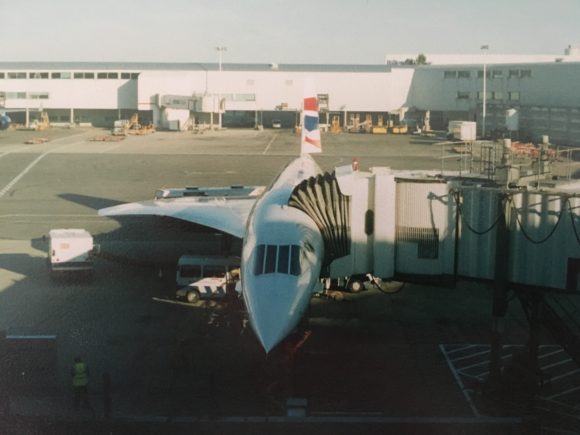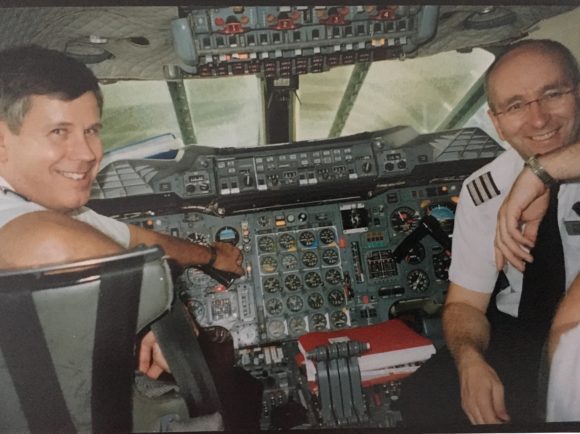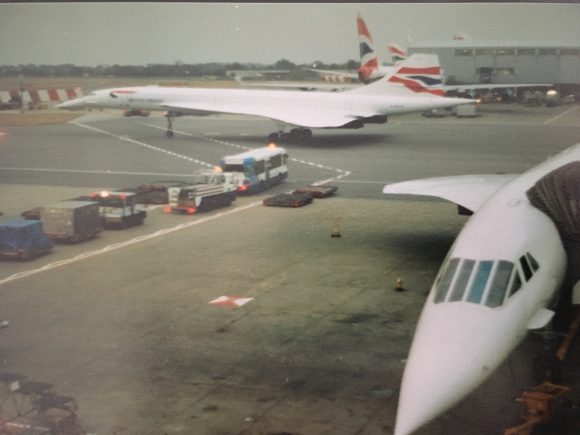“Like never before in a civil aircraft, I am pushed in the back of my seat. You feel the speed, the gear rumbling underneath with each groove the wheels pass. A look outside the window and the world is racing past at some 400 km/h. Then we are airborne, and we climb fast, steep and steady. Soon the afterburners are switched off in order not to disturb the neighbors”.
I quote myself and my own notes about my first ever flight on Concorde. As we celebrate her 50th anniversary of her maiden flight on March 2, 1969, I love to share some moments of this, the most special flights ever done by me.
Concorde Alpha Echo is ready for my flight to JFK. (Richard Schuurman)
Concorde has been my childhood dream, with a rare poster of pre-production aircraft G-AXDN on my wall for many years, later joined by Air France BVFA as both poster and kit model. I first saw her for real at Heathrow in 1987, a moment of huge excitement. I toured AXDN in Duxford twice, the last time in 2000 and only weeks before the end of Concorde began with the crash of Air France BTSC in Gonesse. Concorde made her come back, but when it was announced in 2003 that by October the final British Airways supersonic service was to be scheduled, I had to act. There was no time to lose if I ever was to fly on her.
Fast forward to September 14, 2003, and here is sat in seat 4B. Next to a British policeman, who had been given a single ticket to New York by his wife. Up front in 1A, the Duchess of York Sarah Ferguson. In between on 2C, a middle-aged man in shorts who later preferred to eat his own can of caviar instead of dining the BA way. Some metallic sounds are coming from within the aircraft: she is alive and not the museum piece I have seen before.
Captain Mark Weidner and First Officer Paul Griffin. (Richard Schuurman)
Captain Ron Weidner, FO Paul Griffin, and Flight Engineer Liam Cooper flew the beast, which was BOAE or Alpha Echo for short. They took her for a run from Heathrow’s runway 09R, settling at FL260 and Mach 0.95 until clearing the Welsh coast. Ahead lies the wide Atlantic, ready to be conquered by this majestic and elegant aircraft. At 7.05pm I feel two slight nudges in my back again, but nothing else. It’s the only thing you notice when the afterburners are re-lit and we clear Mach 1.0, just when the cabin crew is about to serve our starter.
At 7.15pm we are already at Mach 1.69 and FL430, higher than I have been before. Another ten minutes have passed, and we clear FL490. The sky above us is getting dark blue, the horizon is becoming a curve. Another hour passes and we hit FL520. We go past Mach 2.0, but there isn’t a wrinkle in my glass that signals I am going faster than ever before.
View from seat 23A in Concorde: the sky is darker than usual. The tail fin is casting a shade on the wing. (Richard Schuurman)
With fuel tanks getting empty, we climb to our maximum altitude at 9.00 pm of FL580. Only astronauts in the space station are flying higher than those on board Concorde. We stay here for only half an hour until 9.33pm, when we start our descend towards New York and shed off our speed step-by-step to Mach 1.84, 8 minutes later we are an ‘ordinary’ aircraft again and we continue our journey at Mach 0.95 and FL350.
We further descend until 9.000 feet at Mach 0.46 and head for JFK’s runway 31L. At 5.15 pm local time and 3 hours 28 minutes of flying, BOAE touches down in New York. All have disembarked, but I am still inside the tiny fuselage to enter an even tinier area upfront: the cockpit. Weidner, Griffin, and Cooper are filling out the paperwork, but have time to answer my questions about Concorde and their life after Concorde. Weidner would go on to fly on 747s, Griffin on 777s, but Cooper would lose his job as there were no aircraft needing F/Es anymore.
It’s Alpha Echo again
Four days later I am heading back to London. It’s Alpha Echo again and Paul Griffin is on the right front seat again as well, joining Captain John White and F/E Trevor Norcott. I have opted for seat 23A, a window seat at the back over the wing to see how they work.
I am sitting next to a seasoned Concorde traveler, who has commuted supersonic at least a dozen of times in fifteen years. A businessman himself, he likes Concorde for its efficiency and time-saving. That’s why he shakes his head in disbelief that only 27 years after it began, the supersonic era will be over soon.
After take-off from 31R (without doing the sharp left turn, but a right one instead), it’s another 3 hours and 20 minutes of supersonic pleasure.
It’s with melancholy that after landing at Heathrow’s runway 27R I step off the aircraft. I promise myself and Alpha Echo to see her one day in the museum, not knowing at the time that would mean a trip to Barbados. It still has to happen and except for touring the Air France Concorde in the museum in Sinsheim (Germany), I have to visit other Concordes too.
It will be nothing compared to those two flights in September 2003.
With Alpha Echo back in London, Alpha Delta is about to depart for New York. (Richard Schuurman)
Views: 26







